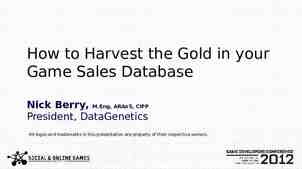Verification of Patient Identification & Blood Product Labeling
30 Slides3.12 MB
Verification of Patient Identification & Blood Product Labeling Educational Services Department 2014
1. Complete Power Point program – be sure to view program in slide show format. 2. After completion of Power Point, you will need to complete the associated posttest. 3. To complete the Verification of Patient Identification & Blood Product Labeling competency, a skill validation is required. 4. Note: This program does not provide continuing education hours. Program Directions
Explain importance of verification of patient identification and blood product labeling. Review key policy and practice expectations for verification process prior to blood product administration. Describe the process for accurate verification of patient identification and blood product labeling. Program Objectives
Explain importance of verification of patient identification and blood product labeling. Objective #1
First a few facts about blood and blood products
Packed Red Cells (PRCs) Platelets Cryoprecipitate Thawed Plasma (FFP Fresh Frozen Plasma) Blood Products
A blood transfusion is a medical treatment that replaces blood lost through injury, surgery, or disease. The blood goes through an intravenous (IV) catheter into the patient’s vein. Most patients receiving a blood transfusion are receiving Packed Red Cells (PRCs). Packed Red Cells A concentration of Red Blood Cells obtained from whole blood by removing the plasma.
Platelets The cells that circulate within our blood and bind together when they recognize damaged blood vessels . When you get a cut, for example, the platelets bind to the site of the damaged vessel, thereby causing a blood clot. Platelets stop the bleeding.
Cryoprecipitate A frozen blood product prepared from plasma. Used most commonly for replacement of fibrinogen in patients who are bleeding. Fibrinogen helps form blood clots.
Thawed Plasma (FFP Fresh Frozen Plasma) The plasma taken from a unit of whole blood. Plasma contains all coagulation factors. Plasma is free of red blood cells, leukocytes, and platelets. One unit is approximately 250mL and must be ABO compatible. Rh factor need not be considered. Continue on for more information about ABO and Rh factor compatibility
The four major blood groups are determined by the presence or absence of two antigens, A and B, on the surface of red blood cells: Group A has only the A antigen on red cells (and B antibody in the plasma) Group Antigen: B has only the B antigen on red A substance that when cells (and Aintroduced antibodyinto in the the plasma) body Group AB has both A and Bresponse antigens on stimulates an immune the production of red cells (butand neither A nor B antibody in antibodies. the plasma) Group O has neither A nor B antigens on red cells (but both A and B antibodies in the plasma) Blood types
Rhesus (Rh) factor is an inherited trait that refers to a specific protein found on the surface of red blood cells. If your blood has the protein, you are Rh positive which is the most common Rh factor. If your blood lacks the protein, you are Rh negative. What is Rh compatibility?
Accurate patient identification is of the utmost importance when patients are being transfused with blood or blood products.
If incompatible blood is given, the donor cells are treated as if they were foreign invaders, and the patient's immune system attacks them. Not only is the blood transfusion rendered useless, but a potentially massive activation of the immune system and clotting system can cause shock, kidney failure, circulatory collapse, and death.
Accurate verification of patient identification and blood product labeling prior to transfusion can prevent serious complications and DEATH!
Review key policy and practice expectations for verification process prior to blood product administration. SLUHN Policy - Blood Transfusion/Transfusion Reaction [D-45], NPPM Objective #2
Before initiating a blood or blood component transfusion, the patient is objectively matched to the blood or blood component during a two person bedside or chair-side verification process.
In addition to patient identification, the following are also verified prior to initiating a blood or blood component transfusion: ABO and Rh compatibility, blood component expiration date and time, and any special transfusion requirements.
Leukoreduced – the removal of leukocytes (white blood cells) Irradiated – prevents the rare complication of transfusion-associated graft-vs-host disease; indicated for patients at particular risk CMV-Negative – the blood of a person who has never had CMV (cytomegalovirus, a common herpes virus) will test negative for antibodies to the infection and will be described as having CMV-negative blood Special requirements
Verification of patient identification and blood product labeling must be verified by two personnel, one of whom is an RN, MD, DO, or PA. Most often this individual is a RN who is the transfusionist.
A qualified individual who may conduct the verification process with the transfusionist can be a: Registered Nurse Licensed Practical Nurse Patient Care Assistant The qualified individual performing the verification process with the transfusionist is the “witness”.
Describe the process for accurate verification of patient identification and blood product labeling. Objective #3
The verification process is completed at the patient’s bedside or chair-side. The transfusionist holds and verifies information on the blood component including the unit bag label and the unit tag. The witness holds and verifies information on the transfusion record.
Verification of Patient Identification: 1. Ask patient to state name and date of birth. 2. Transfusionist or witness compares information stated by patient with information on patient ID bracelet. (Note: Incompetent inpatients will be identified by comparing the name, date of birth and medical record number on the identification bracelet with the registration information or other part of the medical record.) 3. Transfusionist reads patient identification information (patient name, date of birth, and medical record number) on the unit bag label and unit tag while witness verifies information on transfusion record. 4. Witness reads patient identification information (patient name, date of birth, and medical record number) on transfusion record while transfusionist verifies information on unit bag label and unit tag.
Verification of Blood Product Labeling: When the transfusionist reads each of the items on the unit bag label and unit tag the witness verifies the information on the transfusion record. When the witness reads each of the items on the transfusion record the transfusionist verifies the information on the unit bag label and unit tag. TRANSFUSIONIST WITNESS
Transfusionist reads blood product type; witness verifies Witness reads blood product type; transfusionist verifies Transfusionist reads blood type (ABO) and Rh compatibility; witness verifies Witness reads blood type (ABO) and Rh compatibility; transfusionist verifies Transfusionist reads special requirements (if applicable); witness verifies Witness reads special requirements (if applicable); transfusionist verifies Transfusionist reads unit/blood product number; witness verifies Witness reads unit/blood product number; transfusionist verifies Transfusionist reads volume (mL); witness verifies Witness reads volume (mL); transfusionist verifies Transfusionist reads expiration date and time; witness verifies Witness reads expiration date and time; transfusionist verifies Verification of blood product labeling
The transfusionist and the witness sign and date the transfusion record to indicate the verification was completed and all information is accurate. Last step
Remember Every time a blood product is ordered, verification of patient identification and blood product labeling must be done.
Now that you have completed the Power Point, please proceed to take the posttest. Don’t forget, the final step is to complete the Verification of Patient Identification & Blood Product Labeling competency: The skill validation will use the skill guidelines presented in this program. Staff must be 100% accurate in performing the verification process. See your unit/department educator, manager, or resource.
THANK YOU



































